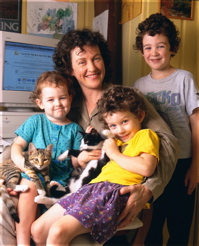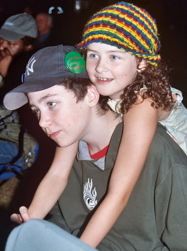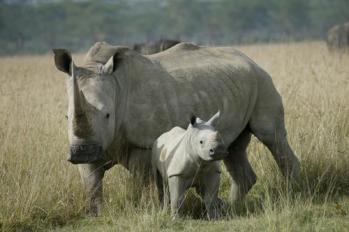Vaccinating all 12-year-old girls against the virus which causes most cervical cancers could cut deaths from the disease by 75 percent, saving thousands, a study has found. (BBC)
Baby Boom for World’s Rarest Rhino Species
Scientists have found signs of four Javan rhinos born in recent weeks in Indonesia, a surprising baby boom for a species that may be reduced to fewer than 60 individuals worldwide…
Signs of the rhino calves were discovered in Indonesia’s Ujung Kulon National Park by a team of biologists who were checking on the rhinos after the recent earthquake on the island of Java. These are the first known births for the Javan rhinos in three years.
“Javan rhinos are probably the rarest large mammal species in the world,” said Arman Malolongan, a director at Indonesia’s Ministry of Forestry. “To discover that this population is breeding, and even slowly growing, gives us hope for the species’ future.”
Javan rhinos are the rarest of the world’s five rhino species. It is estimated that between 28 and 56 Javan rhinos live in Ujung Kulon.
The team found the first sign of a calf a few weeks ago, with the discovery of a small footprint (about 16-17 cm) along with a larger footprint belonging to the mother. One day after this first discovery, another set of mother and calf footprints of slightly different size was found in a different area. Both signs were estimated to be three days old or less. On the same day, a second team came face-to-face with a mother and female calf. And the following day, the team found a fourth small footprint in a different location.
Because of the distance between the four areas where the discoveries were made and the differences in the size of the footprints, the team concluded they are evidence of four different calves.
Javan rhinos are vegetarians that live deep inside the rainforest and it’s very unusual to catch a glimpse of them.
Good News: GNN’s Tenth Year Anniversary!
EDITOR’S BLOG –

Today the Good News Network enters it’s tenth year on the Web.
On August 31, 1997 I was amazed that at the push of a button, what I wrote on my computer at home was instantly available to the whole world. (photo, right, appeared with a story in Women’s World in the fall of that year called, Fed Up With Bad News?) In 2006 I finished the new site design and was again amazed — how easy it would be to upload stories and photos and use all the new software features.
In my continuing effort to offer more people the option of uplifting news, and to mark the occasion, I sent a press release this week to media outlets and newspapers trying to spread the word about our excellent service. Here is the text. If you can bring it to the attention of your local media, that would be excellent…
Daily News Helps Relieve Depression in Viewers
Northern Virginia (August 30, 2006) — There is one daily news service guaranteed to relieve depression brought on by a media overdose on war, terrorism and JonBenet Ramsey. The Good News Network Web site — celebrating its ninth year this week — features daily success stories from around the world — good news from government, science, society and culture. Instead of balance, you’ll hear just one side — the uplifting side.
Founder Geri Weis-Corbley says of the company’s nine-year anniversary this week, “Since the Web site began in 1997, I have received letters from many viewers who claim they actually accrue health benefits while reading our positive news.” According to visitors’ letters displayed on the site, the Good News Network relieved depression and anxiety symptoms brought on by the overdose of depressing news that saturates the Media.
The value of the site also has impressed leaders in the fields of politics and psychology.
Former Secretary of State Colin Powell wrote to the Good News Network: “I enjoyed reading the positive stories . . . (and) am heartened by the goodness and generosity that I see. Keep up your good work.”
Tal Ben-Shahar is a lecturer at Harvard University whose positive psychology course was the most popular class on campus this spring, with 850 students enrolled. He believes the Good News Network can benefit everyone. “It’s an extremely important initiative,” he said. “I recommend that each person makes it a habit to visit the Web site at least once a day — to counter the barrage of negativity in the media. Being exposed to positive information benefits us emotionally, physically, and mentally. It can contribute in a meaningful way to a happier and healthier life.”
The barrage of negativity to which Ben-Shahar referred is steadily intensifying: Despite the fact that the U.S. homicide rate dropped by 42% in the 1990’s, television news coverage of murders skyrocketed 721% (Center for Media and Public Affairs). During that time, TV network news audiences and newspaper circulation continued to fall, which may be related to the mad increase in crime coverage.
More and more people are looking for their news on the Internet. With her newly redesigned site, and its regular daily content updates, Weis-Corbley, who is the editor and publisher, hopes to make daily readers of the 10,000 people who search every month for “good news” on Internet search engines. “We offer the antidote for the hopelessness many people feel after a steady diet of news. We know people need to be informed, but they also need to hear about the successes,” Weis-Corbley said.
Weis-Corbley is a pioneer in the positive news arena, founding the Good News Network nine years ago on August 31 as the first Web site to offer original and compelling positive news programming. She says that with the advent of new technologies today – such as RSS and software for content management and blogging — it is much easier for a small company to publish and link to news content from around the world on a daily basis. “Now it is possible for the Good News Network to amass a large and loyal audience that could rival traditional news networks online,” she said. “The bonus for our readers is that our content benefits their health and well-being. For those suffering from the depression that permeates so much of society, instead of popping a pill, we suggest A Daily Dose of News to Enthuse.”
Weis-Corbley calls on people around the world to sign up for the upcoming e-mail newsletter that will distribute the “Top Ten Good News Stories of the Week”. Also on the website you can download a free copy of the September 11 Commemorative Edition newsletter entitled, “Some Good News!” Our 9/11 memorial newsletter is a testament to the power of positive thinking in the midst of tragedy and a reminder of how good it feels to be reading encouraging news.
For additional information on the Good News Network, contact Geri Weis-Corbley or visit www.goodnewsnetwork.org/
The Good News Network is a media company based in Northern Virginia that has published an online website of positive news and inspiration since 1997 at www.goodnewsnetwork.org.
Contact : Geri Weis-Corbley
1 (866) Good News (466-3639)
Donors pledge Palestinians $500 Million
International donors meeting in Sweden have promised $500 million in aid for the Palestinian territories. A total of $114m would be spent on humanitarian aid, with the rest going towards the rebuilding of infrastructure and other projects. The UN Aid Chief, who organized the drive hoped that this was a moment to begin moving the Palestinian people forward, out of the deepest despair in which they now find themselves. (BBC)
Pitt Unveils Green Housing Contest Winner for New Orleans
Actor Brad Pitt announced the winners of the Sustainable Design Competition for New Orleans yesterday. Pitt, the design jury chairman, unveiled a ‘green’ housing plan for the city’s Lower Ninth Ward that incorporates the newest sustainable technologies to cut pollution and energy costs by 50 to 60 percent and provides for a community center, walkway and garden…
Pam Dashiell, President of the Holy Cross Neighborhood Association where the complex will be built, served as one of the design jury members and described the role of the community process throughout the competition saying, “The amount of community input was incredible; these green building designs breathe new life into our communities.”
Two New York City architects submitted the winning design, of Workshop/APD, dubbed their design Greenola. The plan calls for two multi-family units, six single family houses, services such as child care within a community center, a garden, and a wide pedestrian ramp leading to the adjacent Mississippi River levee.
The idea for the contest, underwritten by Pitt, developed from a conversation between Brad Pitt and Global Green President, Matt Petersen, at the Clinton Global Initiative meeting in New York City in September 2005.
The use of resource-saving appliances and lighting, with solar electricity and hot water heaters, and recycled building materials, will cut pollution and decrease costs to homeowners by 50-60 percent compared with traditional homes.
Global Green USA is currently generating funding partners and developers to begin construction later this year. $100,000 was donated towards the purchase of land in Holy Cross by Trizec Properties Inc. Roughly $3.5 million to $5 million is needed.
Photo: NBC
Basketball Star Sparks Footwear Revolution with NBA-quality Sneakers for Under $15
 Growing up in a Coney Island household with parents struggling to make ends meet, Stephon Marbury knows first-hand the pressure kids, parents and playground basketball players feel to spend top-dollar on the latest clothes and sneakers. Today, as a high-profile NBA player, he’s now embarking on a “change-the-world” mission to eliminate that aspect of our culture and the exorbitant price of sneakers.
Growing up in a Coney Island household with parents struggling to make ends meet, Stephon Marbury knows first-hand the pressure kids, parents and playground basketball players feel to spend top-dollar on the latest clothes and sneakers. Today, as a high-profile NBA player, he’s now embarking on a “change-the-world” mission to eliminate that aspect of our culture and the exorbitant price of sneakers.
World’s Biggest Music Company Offers Free Downloads Beginning Dec
Vivendi Universal has signed a deal to make its music catalogue available on a free legal downloads service. Under the agreement, Spiralfrog will offer Universal’s songs online in the US and Canada, and make its money by carrying advertisements on the site. "Offering young consumers an easy-to-use alternative to pirated music sites will be compelling," Spiralfrog CEO Robin Kent said. (BBC)
Need a Lightbulb? Change the World
 Compact fluorescent lightbulbs have come as far as cell phones since the mid 80’s while still maintaining their high efficiency. What that means is:
Compact fluorescent lightbulbs have come as far as cell phones since the mid 80’s while still maintaining their high efficiency. What that means is:
If every one of 110 million American households bought just one CFL bulb, like this dimmable CF Warm Glow
Lightbulb, took it home, and screwed it in the place of an ordinary 60-watt bulb, the energy saved would be enough to power a city of 1.5 million people. One bulb swapped out, enough electricity saved to power all the homes in Delaware and Rhode Island …
Milwaukee Woman Rescues Butterflies from Development
While bulldozers clear land to create a flood basin, Barb Agnew races to collect monarch eggs on the underside of milkweed leaves, and brings them to an enclosure in the back of her flower shop. She estimates that she’ll rescue about 1,000 monarchs this year. (Seattle P-I)
Significant Coral Reef Regeneration in Arabian Gulf
Researchers studying coral reefs in the Arabian Gulf have found encouraging signs that corals in Abu Dhabi and Qatar are regenerating and the entire range species may be re-established within a decade…
According to the World Wildlife Fund-sponsored coral reef study, at least 18 out of an original 36 species of coral found in the region have recovered from damage suffered due to past climatic events. In particular, Halul in Qatar and Ras Ghanda in Abu Dhabi are two areas where the most vigorous coral regeneration is taking place. Yasat and Dalma islands in Abu Dhabi also recorded good coral growth and high coral cover.
“We are encouraged by the results of the coral reef project,” said Razan Al Mubarak, Director of the World Wildlife Fund office in the United Arab Emirates.
“Assuming no further disturbances to their reef habitat occur, the rate of regeneration suggests that the entire range of the region’s coral species would be re-established within a decade.”
UN Treaty Protects Rights of Disabled
UN Secretary-General Kofi Annan today hailed the agreement reached late Friday on the text of a treaty to protect the rights of persons with disabilities, urging all Member States to ratify the convention and implement it quickly.
Encouraging Sign for Endangered Bird
 Nests of the endangered Great Indian Bustard were sighted in the Kutch region of India — after none were spotted last year — providing a ray of hope that the population could rise. (The Hindu)
Nests of the endangered Great Indian Bustard were sighted in the Kutch region of India — after none were spotted last year — providing a ray of hope that the population could rise. (The Hindu)
New Way for Cancer Cells to Commit Suicide
Healthy cells have a built-in process (to) commit suicide if something is wrong, a process which fails in cancer cells. A University of Illinois team created a synthetic molecule which caused cancer cells to self-destruct.
____________________________________________________________________________________________
The study, in Nature Chemical Biology, offers "exciting possibilities" for new ways of treating Cancer. (BBC)
PlayStation 3 Machines To Help Tackle Disease Research
Sony has teamed up with US researchers to provide the spare processing power of Sony’s PlayStation 3 video game system to harness gamers in helping to understand the cause of diseases like Alzheimer’s. "A network of PS3’s will allow performance similar to supercomputers." (BBC)
Yo-Yo Powered MP3 Player Wins Award
From Treehugger comes a report about a yo-yo powered MP3 player. "The inventors estimate that between 10-12 tosses per hour are sufficient for continuous music play. A wireless headset allows the user to listen to music while yo-yoing." Cool.
Philippines Set Tree-Planting Record
A massive tree-planting campaign in the Philippines set a world record of a half million simultaneous plantings along highways. AP reports the participation was phenomenal proving citizen’s interest in cutting air pollution and beautifying the islands…
Inspiration Point: Teen Years are Some of the Best to Parents
 I am the director of The Natural Child Project , a psychologist, and author of The Natural Child: Parenting From the Heart. I envision a world where all children are treated with dignity, understanding, and compassion.
I am the director of The Natural Child Project , a psychologist, and author of The Natural Child: Parenting From the Heart. I envision a world where all children are treated with dignity, understanding, and compassion.
When asked about the notorious teen years I am often interrupted midway through my statement, "My son is 15 and has brought me nothing but …"
Judge Rules Bush’s Lax Pesticide Law Illegal
 A federal judge in Seattle yesterday overturned new Bush administration rules that weaken the governing of pesticide use and their effect on endangered plants and animals. The court struck down the EPA’s new rules and restored prior standards that provided greater protection to protected wildlife. The judge determined that the rules were “arbitrary and capricious” because they ignored the risks to species and because EPA political appointees ignored the unanimous concerns of its own scientists.
A federal judge in Seattle yesterday overturned new Bush administration rules that weaken the governing of pesticide use and their effect on endangered plants and animals. The court struck down the EPA’s new rules and restored prior standards that provided greater protection to protected wildlife. The judge determined that the rules were “arbitrary and capricious” because they ignored the risks to species and because EPA political appointees ignored the unanimous concerns of its own scientists.
Black Rhino Numbers Up 20 Percent
 Black rhino numbers are on the rise in Kenya after years of decline from poaching and habitat loss.
Black rhino numbers are on the rise in Kenya after years of decline from poaching and habitat loss.
According to officials, the country’s black rhino population has increased 20 percent, from 428 animals in 2003, to 539 animals at the end of 2005…
“This shows a healthy increase that surpassed our targets,” said Dr Taye Teferi, a Conservation Programme Director with the World Wildlife Fund, based in Nairobi. “Considering the intense poaching pressure and the demand for rhino horn, this is no mean achievement.”
The population growth is attributed to improved rhino protection, particularly through managing existing populations and ensuring that their habitats are suitable for foraging and reproducing.
WWF, through its black rhino project, is working with the Kenya Wildlife Service to increase Kenya’s black rhino population to 1,000 by 2020 through the expansion of existing rhino sanctuaries and through the establishment of new protected areas that can accommodate future population growth.
“With increased improvement in wildlife management and monitoring, the black rhino population can continue to show a healthy growth rate for many years to come,” added Dr Teferi. (WWF)
Disney Donates Endangered White Rhinos to Uganda
 To boost populations of white rhinos in their native Uganda, Disney’s Animal Kingdom in Florida sent two of the huge animals on a four-day journey to Africa where they walked on ancesteral soil for the first time. It is hoped the two will breed within a year in their new home, the Ziwa Rhino Sanctuary. (AP via Washington Post)
To boost populations of white rhinos in their native Uganda, Disney’s Animal Kingdom in Florida sent two of the huge animals on a four-day journey to Africa where they walked on ancesteral soil for the first time. It is hoped the two will breed within a year in their new home, the Ziwa Rhino Sanctuary. (AP via Washington Post)
Photo by Renaud Fulconis, rhinos-irf.org




















